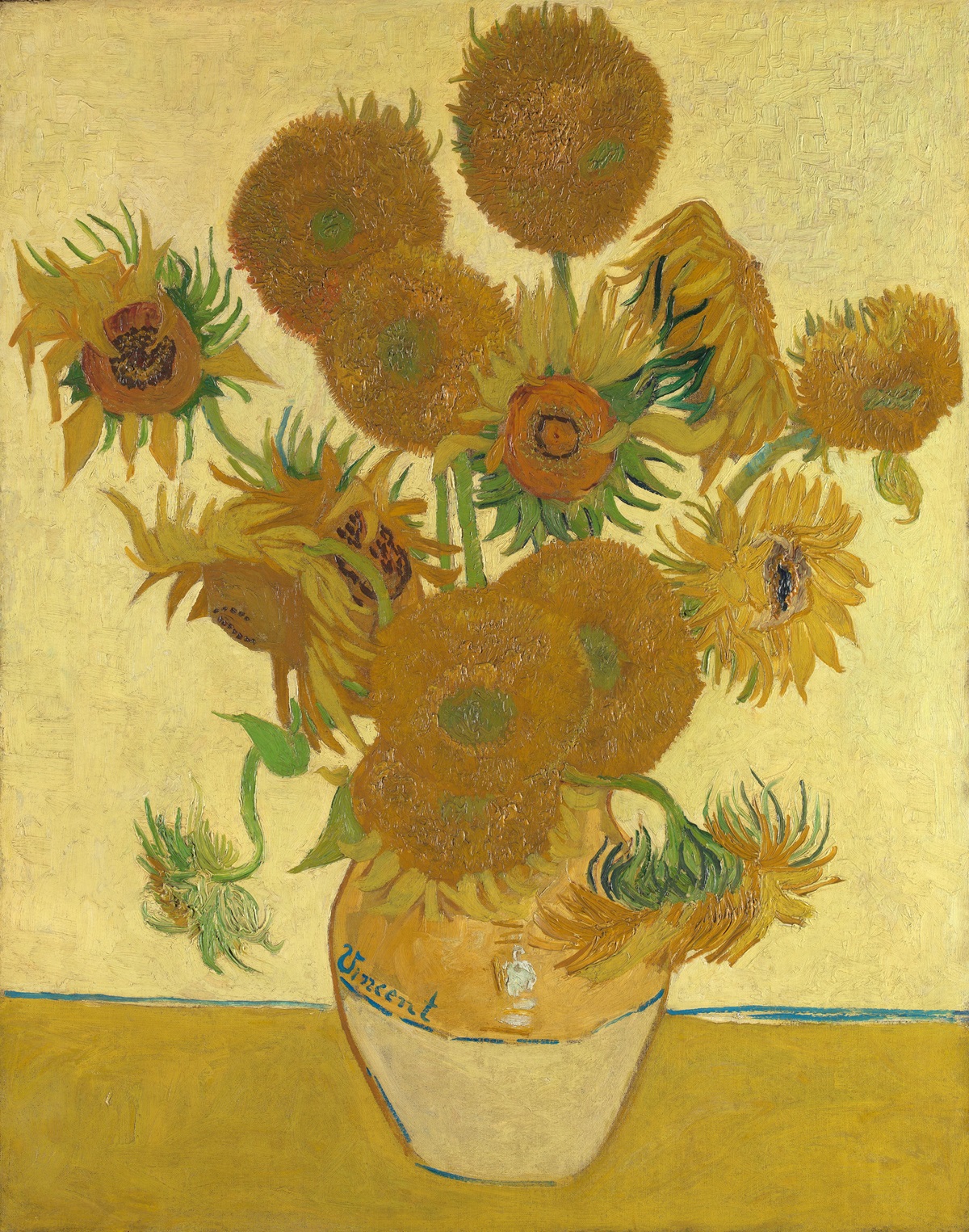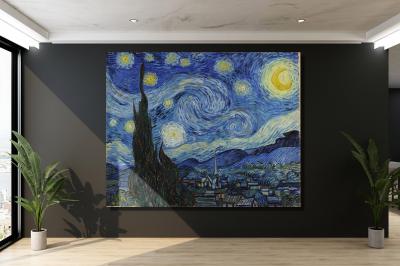Sunflowers
By Vincent van Gogh, 1887
The Radiant Legacy: Vincent van Gogh’s Sunflowers”
Few paintings in the annals of art history have attained the iconic status and enduring allure of Vincent van Gogh’s “Sunflowers.” This masterful series, conceived during the late 19th century, continues to captivate audiences worldwide with its vibrant colors, emotive brushwork, and the profound narrative it weaves. In this comprehensive exploration, we will dive into the origins, technical challenges, significance, and enduring influence of this extraordinary work of art, while also considering its unique location. Furthermore, we will delve into the life and artistic journey of Vincent van Gogh, the genius behind “Sunflowers.”
The Genesis of “Sunflowers”
Vincent van Gogh’s “Sunflowers” is not a solitary artwork but a series of variations, each representing a distinct facet of his unique artistic journey. This series encompasses five distinct versions, painted between 1888 and 1889, with two of these revered pieces residing in the Van Gogh Museum in Amsterdam.
Van Gogh’s fascination with sunflowers burgeoned during his sojourn in Arles, France, where he dreamt of creating a welcoming ambiance for his fellow artist and dear friend, Paul Gauguin. The sunflower, with its radiant yellow petals, metamorphosed into an emblem of friendship and warm hospitality. Moreover, it encapsulated the concept of personal growth and rejuvenation, as sunflowers meticulously track the sun’s trajectory across the sky.
“Sunflowers” Large Canvas Prints from WhiteClouds
The Enchantment of Color
What sets “Sunflowers” apart is its extraordinary utilization of color. Van Gogh’s palette here orchestrates a symphony of yellows, spanning the spectrum from the deepest gold to the most delicate lemon. The vivid, nearly surreal hues of the sunflowers set against a backdrop of resplendent yellow conspire to create a sense of intensity and vitality that verges on the tangible. The selection of complementary colors further amplifies the visual impact, causing the sunflowers to leap off the canvas.
However, it is not just the chromatic brilliance that ensnares the observer. Van Gogh’s brushwork is equally mesmerizing. Employing a technique known as impasto, he layers thick applications of paint, bestowing upon the canvas a three-dimensional texture that beckons the viewer to reach out and engage with the artwork physically. This distinctive technique affords the artist the ability to capture the interplay of light and shadow on the petals, thus infusing the composition with depth and intricacy.
Technical Challenges and Triumphs
Behind the captivating beauty of “Sunflowers” lies a series of technical challenges that Vincent van Gogh confronted with determination and innovation. The impasto technique he employed, with its thick layers of paint, required patience and a deep understanding of color theory. The risk of overworking the canvas or causing the paint to crack was ever-present. However, van Gogh’s mastery of texture and color allowed him to navigate these challenges, resulting in a masterpiece that endures to this day.
Location and Legacy
Vincent van Gogh’s “Sunflowers” holds a unique place not only in the art world but also in the cultural heritage of the Netherlands. Two of the five versions are housed at the Van Gogh Museum in Amsterdam, a fitting location for these iconic works of Dutch post-impressionism. The museum provides an opportunity for art enthusiasts from around the world to witness the brilliance of “Sunflowers” up close and appreciate its technical intricacies.
The Artist: Vincent van Gogh
Vincent van Gogh, the enigmatic genius behind “Sunflowers,” was a Dutch Post-Impressionist painter whose tumultuous life and groundbreaking work have left an indelible mark on the art world. Born in 1853 in Zundert, Netherlands, van Gogh’s artistic journey was marked by relentless passion and relentless self-exploration.
Van Gogh’s early life was marked by struggles, including episodes of mental illness and poverty. However, his passion for art led him to create over 2,000 works of art during his brief but prolific career. His style evolved from somber, earth-toned pieces to the vibrant and expressive works that define his later period, including “Sunflowers.”
Despite facing numerous personal and professional challenges, van Gogh’s dedication to his craft remained unwavering. His unique vision and innovative techniques, such as impasto and bold use of color, revolutionized the art world and laid the foundation for modern art movements.
Tragically, Vincent van Gogh’s life was cut short when he died by suicide in 1890 at the age of 37. However, his legacy lives on through his art, which continues to inspire and captivate audiences worldwide.
 Sunflowers by Vincent van Gogh
Sunflowers by Vincent van Gogh
Conclusion
In the pantheon of art history, Vincent van Gogh’s “Sunflowers” stands as a testament to the potency of color, emotion, and personal expression. It is not merely a painting; it is a radiant legacy that urges viewers to contemplate the intricate interplay between the artist’s inner universe and the external allure of the natural world. “Sunflowers” is an enduring masterpiece, a beacon that reminds us of art’s enduring impact on the human spirit, and a confirmation to the profound resonance that transcends generations. Its location at the Van Gogh Museum in Amsterdam adds an extra layer of significance, making it an integral part of the Dutch cultural heritage and a destination for art enthusiasts worldwide. Meanwhile, Vincent van Gogh’s own tumultuous life and groundbreaking contributions to art ensure that his name and his work will continue to be celebrated and studied for generations to come.
Frequently Asked Questions About “Sunflowers”
“Sunflowers” by Vincent van Gogh is undoubtedly one of the most iconic and well-known paintings in the world of art. As such, it generates a host of frequently asked questions among art enthusiasts, historians, and curious individuals alike. Here are some common questions about “Sunflowers” and their answers:
What is the significance of “Sunflowers” in Vincent van Gogh’s body of work? “Sunflowers” represents a pivotal moment in van Gogh’s artistic journey. It reflects his fascination with color and texture and his use of art to convey emotions and personal experiences.
How many versions of “Sunflowers” did van Gogh create? Vincent van Gogh painted a total of five different versions of “Sunflowers.” Two of these are housed at the Van Gogh Museum in Amsterdam.
What inspired van Gogh to paint sunflowers? Van Gogh’s inspiration for painting sunflowers was rooted in his desire to create a welcoming atmosphere for his friend and fellow artist, Paul Gauguin, who was coming to visit him in Arles, France.
Why are sunflowers such a recurring motif in van Gogh’s work? Sunflowers represented more than just a subject for van Gogh. They symbolized friendship, vitality, and the cycle of life, making them a recurring motif that carried personal significance.
What is the meaning behind the vibrant colors in “Sunflowers”? The vibrant colors in “Sunflowers” are a reflection of van Gogh’s emotional intensity and the way he perceived the world. They convey his optimism and the desire to bring beauty to the viewer.
What techniques did van Gogh use in “Sunflowers”? Vincent van Gogh employed a thick impasto technique in “Sunflowers.” He applied layers of paint with a palette knife, creating a textured, three-dimensional effect that adds depth and vitality to the composition.
Where is the original “Sunflowers” painting located? The two most well-known versions of “Sunflowers” are housed in the Van Gogh Museum in Amsterdam, Netherlands. Other versions can be found in different museums and private collections around the world.
How has “Sunflowers” influenced the art world and popular culture? “Sunflowers” has had a profound impact on art history and popular culture. It has inspired countless artists and has been reproduced on various products, from posters and postcards to home décor items.
What is the historical context of “Sunflowers”? “Sunflowers” was painted in the late 19th century, during a period of intense creativity for van Gogh. It was a time when he was living in Arles, France, and had formed strong artistic bonds with other renowned painters.
Why is “Sunflowers” considered a masterpiece? “Sunflowers” is considered a masterpiece due to its innovative use of color, texture, and emotion. It captures van Gogh’s unique artistic vision and continues to captivate viewers with its beauty and depth.
These frequently asked questions provide insight into the fascination and enduring appeal of Vincent van Gogh’s “Sunflowers,” shedding light on the artistic genius behind this iconic series of paintings.
Other Articles on Vincent van Gogh Paintings
At Eternities Gate by Vincent Van Gogh, 1890
Blossoming Almond Tree by Vincent Van Gogh, 1890
Cafe Terrace at Night by Vincent Van Gogh, 1888
Daubigneys Garden by Vincent Van Gogh, 1890
Green Wheat Field with Cypress by Vincent Van Gogh, 1889
Houses at Auvers by Vincent Van Gogh, 1890
Irises by Vincent Van Gogh, 1889
Night Café by Vincent Van Gogh, 1888
Portrait of Dr. Gachet by Vincent Van Gogh, 1890
Red Vineyards by Vincent Van Gogh, 1888
Road with Cypress and Star by Vincent Van Gogh, 1890
Starry Night by Vincent Van Gogh, 1889
Starry Night over the Rhone by Vincent Van Gogh, 1888
Sunflowers by Vincent Van Gogh, 1887
The Bedroom by Vincent Van Gogh, 1888
The Church at Aurers by Vincent Van Gogh, 1890
The Garden of the Asylum by Vincent Van Gogh, 1889
The Mulberry Tree by Vincent Van Gogh, 1889
The Potato Eaters by Vincent Van Gogh, 1885
The Yellow House by Vincent Van Gogh, 1888
Tree Roots by Vincent Van Gogh, 1890
Van Gogh Self Portrait by Vincent Van Gogh, 1887
Vase with Red Poppies by Vincent Van Gogh, 1886
View of Arles by Vincent Van Gogh, 1889
Wheat Field with Crows by Vincent Van Gogh, 1890
Wheat Field with Cypresses by Vincent Van Gogh, 1889
More WhiteClouds Videos
Contact us today to learn more about our 3D services and how we can help you achieve your goals.

